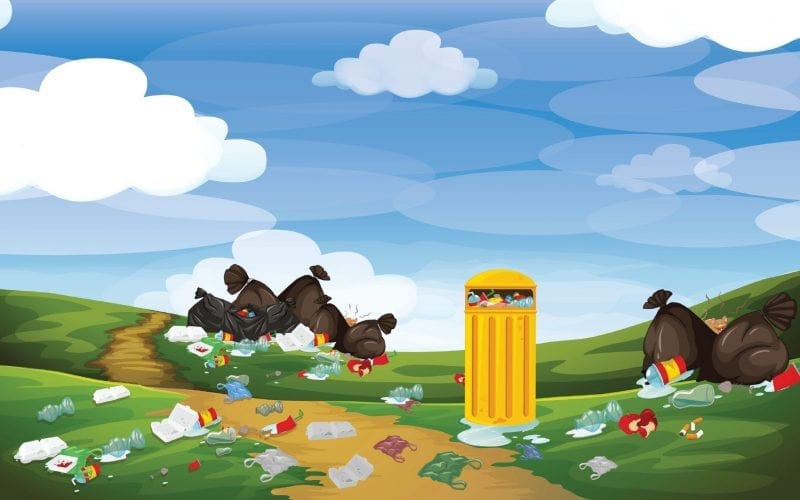The constant release of harmful chemicals from factories as well as the rapid urbanisation and depletion of forests had lead to reduced water levels and increase in toxins in the soil. This has caused a hazardous impact on our environment. As the world grew conscious of the pollution as well as increasing exhaustion of our limited resources, many concerns are raised to address the different types of pollution. Floods, landslides, earthquakes, forest fires are only some of the natural disasters which are amongst the major implications of pollution. Through this blog, we will explore what soil pollution is, its effects as well as prospective measures we can adapt to tackle it.
Recommended Read: How to Become an Environmentalist?
What is Soil Pollution?
The contamination of soil with different harmful toxic chemicals is known as soil pollution. Soil pollution causes perilous effects on our environment and leads to several health hazards. When harmful chemical and toxic elements are released into the soil, it can turn to be extremely dangerous for human beings. The prime reason for soil pollution is the addition of harmful chemicals artificially, especially while farming. Some of the causes of soil pollution are given below:
- Excessive use of pesticides or fertilisers in agriculture.
- Releasing industrial chemicals and wastes directly into soil without their proper treatment.
- No proper drainage system for waste disposal. Open disposal of waste in soil is harmful.
Check Out: Essay on Sustainable Development
Major Pollutants
The main components of soil pollution are known as ‘xenobiotics’. This word is of Greek origin where ‘Xenos’ means foreigner and ‘Bio’ means life. Thus Xenobiotics are something which are not naturally present in the soil but are added to the soil artificially by humans. The different types of pollutants that are found in soil are given as follows:
- Heavy metals
- Hydrocarbons
- Mineral oil, amongst others.
Let us discuss the presence of these soil pollutants to understand their harmful effects on soil as well as human beings.
Heavy metals
Presence of heavy metals in high concentrations is harmful for the human population. Not only do they cause soil pollution, but they increase the toxins already present in the soil thus harming the crops or produce grown in it. The toxic metals are generally added in soil due to pesticides, medical wastes, agricultural wastes, etc. Below are some heavy metals that produce toxins and harmful chemicals leading to soil pollution.
- Mercury
- Lead
- Copper
- Nickel
- Thallium
- Antimony
- Zinc
- Arsenic
- Chromium
- Antimony
Hydrocarbons
As the name suggests, it is a combination of hydrogen and carbon and the presence of these hydrocarbons causes severe health issues to human beings such as cancer and cardiovascular diseases. Some examples of hydrocarbons are Naphthalene, Phenalene and Anthracene, etc.
Must Read: Environmental Science Courses
Effects of Soil Pollution
Soil pollution has its hazardous implications on human beings, animals as well as plants alike. However, the effect on different living beings is different and has to be dealt with differently.
Effect on Human Beings
The contaminants of soil can be present in all three forms, i.e. solid, liquid and gas. Thus, there are possibilities that the contaminants can enter the human body through skin contact or breathing. There are both short-term and long-term repercussions of the contaminants. The short-term effects are:
- Skin irritation
- Respiratory problems
- Coughing
- Fatigue
- Nausea
The long-term effects can be as follows:
- Cancer
- Problem in the nervous system
- Kidney or liver damage
Must Read: Career in Environmental Chemistry
Effect on Plants and Animals
Due to the high concentration of soil pollutants when the plants grow in the same soil, they undergo the process of bioaccumulation. This affects the growth of the plant and it accumulates various toxins. When any herbivore animal or even a human being intakes such harmful fruits from these plants, the toxins can get shifted from an animal to humans as well. In this way, the entire ecosystem is affected by soil pollution
Effective Control Measures
Soil pollution can be controlled if proper care is taken and the harmful acts are reduced. The remediation would certainly take time and already many measures are being taken by organic farmers and the government to improve soil quality and reduce soil pollution. Some of the ways to control soil pollution are:
optin-monster-shortcode id=”xf2mlnjiouddzrshykdb”]
- Proper waste management: Harmful wastes can be transported to locations that are empty and uninhabited and then these materials can decomposed accordingly.
- Reduction of usage of pesticides, fungicides, etc. for agriculture.
- Bioremediation, Mycoremediation and thermal remediation also prove to be useful amongst remedial processes for minimizing soil pollution.
Related Read: Career in Oceanography
Thus, we hope that this blog provided you with a detailed analysis of soil pollution. If you aim to study a degree in Environmental Science, book an E-meeting with our experts at Leverage Edu and we will guide in selecting the right course and university that fits your interests and preferences.

 One app for all your study abroad needs
One app for all your study abroad needs






















 45,000+ students trusted us with their dreams. Take the first step today!
45,000+ students trusted us with their dreams. Take the first step today!


